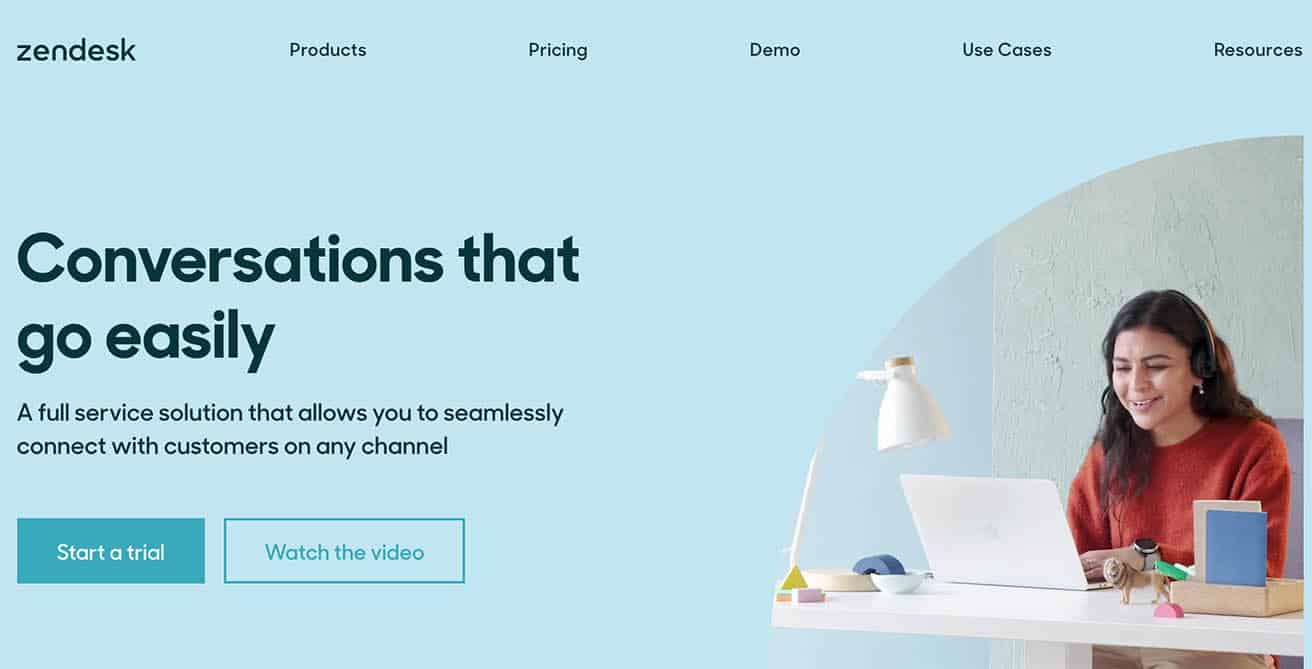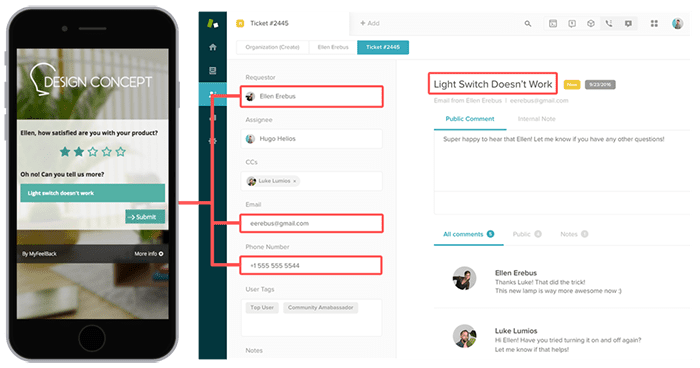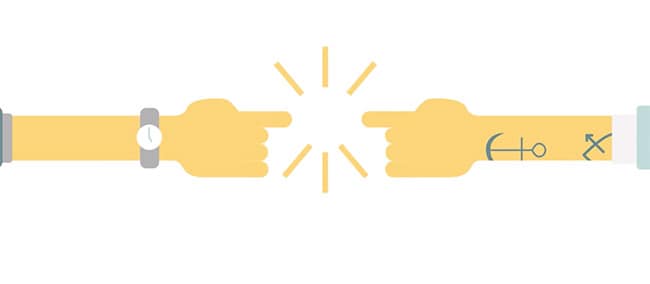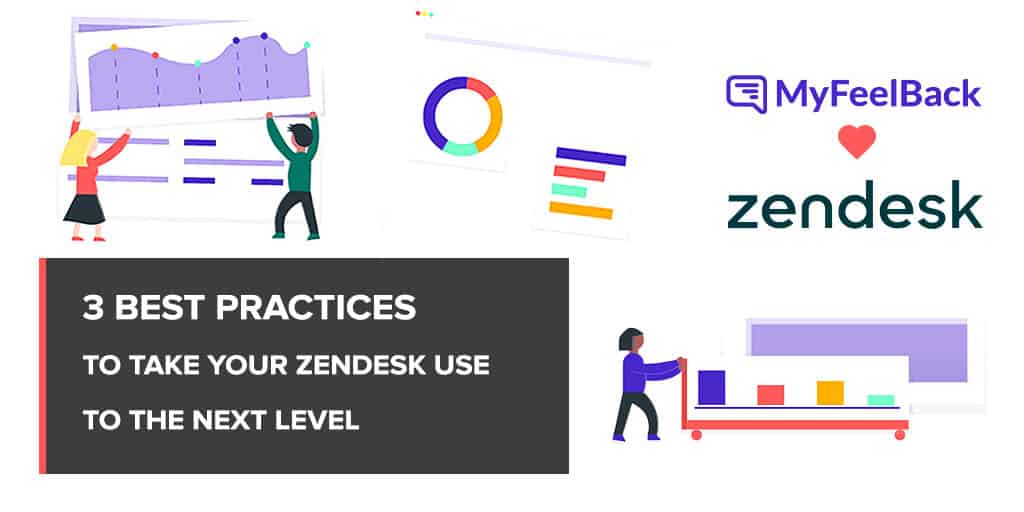Zendesk is a leader on the CRM market. The ticket management software allows you to manage customer interactions at your various brand touchpoints. A complete and powerful solution, Zendesk offers a wide range of products covering all the main CRM and marketing use cases. If you are reading this, you are probably looking for ways...
Zendesk is a leader on the CRM market. The ticket management software allows you to manage customer interactions at your various brand touchpoints. A complete and powerful solution, Zendesk offers a wide range of products covering all the main CRM and marketing use cases.

If you are reading this, you are probably looking for ways to better exploit this powerful CRM tool. Which is precisely the object of this article. You will find below a detailed presentation of three effective and easy-to-implement best practices, to help you take your use of Zendesk to the next level and improve your teams’ productivity and efficiency:
- Integrating satisfaction scores (such as the Net Promoter Score) into your contacts and Zendesk tickets.
- Identifying and immediately dealing with dissatisfied customers.
- Enriching your customer database to improve the handling of requests.
1 – Integrating satisfaction scores into Zendesk tickets, contact files and dashboards
A CRM software has two main uses:
- Centralising all of your customer data, as well as the relationship history.
- Centralising customer interaction management on all channels: help centres, telephone, chat, social media, email, contact forms, etc.
Zendesk provides a solution for both of these use cases. The software allows you to manage customer requests in the form of tickets, and also to unify the data you have on each of your contacts through information files. This data, displayed in the tickets, allows your operational teams to personalise the handling of requests.
Zendesk users still only rarely use this data relating to their contacts’ level of satisfaction. Below we will explain why and how to integrate satisfaction scores into contact files and tickets.
Why integrate customer satisfaction scores into Zendesk?
You can measure customer satisfaction with satisfaction indicators. Several exist, amongt the most frequently used are:
- The Net Promoter Score or NPS.
- The Customer Satisfaction Score or CSAT.
- The Customer Effort Score or CES.
If you are not already familiar with these names, have a look at our article: Customer Satisfaction: Do you know the 4 key measures?
Why should you integrate a satisfaction indicator into your Zendesk CRM? There are 4 main reasons:
To further individualise and personalise the customer experience
The handling of customers and their requests should be adapted to each individual customer. You would not address an unhappy customer in the same way as a promoter customer. By integrating satisfaction scores into your Zendesk CRM contact files and tickets, your teams can easily check a contact’s level of satisfaction and adjust the way they handle them accordingly. Which ultimately leads to an improved customer experience.
To prioritise the handling of customer requests
When your contacts’ requests reach a certain volume, it becomes necessary for your teams to arrange them in order of priority. What criteria should be used to identify which requests are the most urgent? Answer: satisfaction indicators are one of the most important criteria. For example, you could prioritise the most dissatisfied customers.
To manage overall customer satisfaction
At a “macro” level, satisfaction indicators enable you to measure to what extent your services meet your customers’ expectations / needs. By adding these to your dashboards, you can monitor how your customers’ overall satisfaction evolves with regards to key elements. This approach is particularly helpful for identifying areas for improvement.

To develop a customer segmentation
You can use satisfaction indicators to create a customer segmentation, which will help you improve the marketing actions deployed on Zendesk Connect. The Net Promoter Score for example, allows you to categorise your customers: “promoters”, “passives” and “detractors”. It could make sense to design marketing campaigns based on each of these three customer categories.
How do you integrate a satisfaction indicator into Zendesk?
There is only one way to know how satisfied your customers are – by asking them in a satisfaction survey. MyFeelBack’s solution allows you to immediately deploy a survey on the channels of your choice, and to automatically feed the answers into your Zendesk CRM with the native connector we have developed.
Beyond the set-up, there is nothing more for you to do. Every time a customer completes a survey, their score is automatically integrated into their Zendesk file.
We also recommend integrating the satisfaction indicator into your dashboards, so that you can monitor your indicator’s overall evolution.

2 – Identifying and immediately handling dissatisfied customers
The native connector we have developed allows to easily integrate MyFeelBack with your Zendesk CRM. As seen above, the first benefit of this integration is that it allows to integrate one or more satisfaction indicators into your Zendesk tickets, information files and dashboards.
The second best practice consists in automating the creation of a Zendesk ticket every time a customer expresses dissatisfaction.
More about the “mechanics” of this use case
Let’s take a concrete example. One of your customers receives a satisfaction survey via email following the delivery of an order. Note that with MyFeelBack, you can deploy surveys on lots of different channels other than email; your website in the form of a pop-in or chat, social media, your mobile app, etc.
Back to our example. The customer who has just received the survey is not satisfied with the delivery. To the question: “Would you recommend our delivery service to others?” (= the NPS question), the customer gave a rating of 2, on a scale of 0 to 10. Once the satisfaction survey has been completed, a ticket is automatically created in Zendesk, so that an agent can contact the dissatisfied customer. The MyFeelBack – Zendesk connection allows to automatically generate a Zendesk ticket every time a customer expresses dissatisfaction.

This use case is particularly important because, as you know, poor management of customer dissatisfaction can cost a company dearly – both in terms of brand image and revenue loss. To read more about this, have a look at our article: “How to manage dissatisfied customers”. By automatically creating tickets, your customer services can immediately and proactively handle dissatisfied customers.
3 – Increasing Customer Knowledge by enriching your Zendesk customer base
The quality of customer experience and the performance of your marketing actions depend on your level of Customer Knowledge. A better knowledge of your customers allows you to improve the personalisation and targeting of your relationship actions, whether deployed by customer services or marketing (via Zendesk Connect).

Zendesk is a Ferrari that needs fuel – customer data. Enriching your customer data is key for exploiting Zendesk’s full potential and taking your use to the next level.
Here are a few examples of what information you can ask your customers for, to enrich your Zendesk customer base:
- Socio-demographic data: sex, age, etc.
- Channel preferences: email, telephone, SMS? It is also particularly interesting to integrate this information into Zendesk to improve customer interactions. Your customers will appreciate you using their preferred channel.
- “Psycho-graphic” data: interests, favourite products/product categories, general preferences, etc. With this information, you can better personalise your communications and offers.
To collect this information, we once again recommend customer surveys – in addition to analytical tools. With the MyFeelBack solution, you can ask your customers questions of your choice and automatically feed them into your Zendesk CRM (via specially created ad hoc data fields).
Conclusion
You can quickly enrich your Zendesk use and improve your teams’ efficiency by putting in place these three best practices. All three are based on customer data. We are convinced that CRM performance depends on both the quality of your CRM practice, and the data available. This data is fuel for both customer services and the customer experience. A tool such as MyFeelBack allows you to both improve your practices and enrich your customer base with ready-to-use data for your operational teams.









